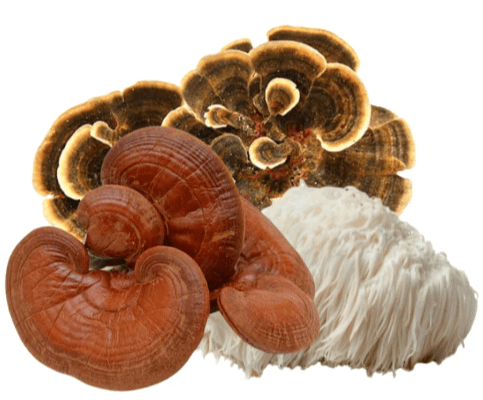

Mushrooms as Medicine
This website offers comprehensive insights into the world of medicinal mushrooms, delving into their remarkable health benefits and therapeutic potential.
With a particular emphasis on:
- importance of mushroom extracts
- how to discern high-quality products
- clinical use of medicinal mushrooms
The world of Medicinal Mushrooms
Until recently, mushrooms were commonly believed to belong to the plant kingdom. However, in 1969, they were given their own distinct Fungi kingdom, as they are neither plant nor animal.
A fungus is primarily comprised of an underground mycelial network, with the familiar above-ground structure (the mushroom) serving as the reproductive organ responsible for spreading spores. There are hundreds of thousands of fungi species, with many more waiting to be discovered.
Used for thousands of years across various cultures, mushrooms have been scientifically proven to promote health and address a wide range of health issues.
This growing industry of medicinal mushrooms holds great potential to benefit human health and well-being as further research continues to uncover the therapeutic properties of different mushroom species.
Historic use of Medicinal Mushrooms
Mushrooms have a rich history of medicinal use dating back thousands of years across various cultures worldwide. Ancient civilizations such as the Egyptians, Greeks, and Chinese recognized the healing properties of certain fungi and incorporated them into their traditional medicine practices.
In China, mushrooms like Reishi, Shiitake and Cordyceps were prized for their ability to promote longevity, boost immunity, and improve vitality. These mushrooms were often brewed into teas or included in culinary dishes as a means of enhancing health and vitality.
Similarly, in ancient Egypt, mushrooms were revered for their medicinal benefits. Hieroglyphics depict the use of mushrooms in religious ceremonies and healing rituals. Mushrooms were believed to possess mystical properties and were used to treat various ailments.
In medieval Europe, mushrooms were used by herbalists and apothecaries to treat a wide range of illnesses. They were particularly valued for their ability to alleviate symptoms of infections and boost the immune system.
From traditional remedies to cutting-edge medicine, the historic use of mushrooms for medicinal purposes continues to inspire exploration and innovation in the field of natural health and wellness.
Scientific Development
Since the 1950s, scientists have increasingly explored the medicinal properties of mushrooms. China and Japan have emerged as leaders and innovators in this research.
The conclusion drawn is that the therapeutic effects are not solely attributable to the mushrooms themselves, but rather to specific substances found in different mushrooms and mycelium.
These substances, termed "secondary metabolites," are recognized as "bioactive" or "Biological Response Modifiers (BRM)."
BRMs trigger biological responses in the body upon consumption.
Generally, mushrooms do not exert a direct effect on health but rather an indirect one, enhancing the body's performance and optimizing homeostasis.
Over the past decades, numerous active compounds have been identified and isolated, with new discoveries made annually. Many of these compounds are beneficial for supporting health and longevity, consistent with traditional usage and beliefs.
In numerous cases, isolated compounds from fungi have facilitated the development of groundbreaking drugs, profoundly impacting medical science.
Notably, antibiotics and statins (cholesterol inhibitors) are among these breakthroughs, with antibiotics considered among the most pivotal drugs ever developed, penicillin being the foremost and most well-known example.
Scientific studies on mushrooms
The research on medicinal mushrooms and their therapeutic applications is continuously expanding.
Notably, a substantial portion of this research is conducted in Chinese, Japanese, and Korean languages, significantly outweighing studies conducted in English.
Below, we outline some key studies that summarize scientific trends and validate the medicinal properties of mushrooms in general. More scientific studies into individual mushrooms under each mushroom page.
Medicinal Mushrooms: Bioactive Compounds, Use, and Clinical Trials
"Medicinal mushrooms have important health benefits and exhibit a broad spectrum of pharmacological activities, including antiallergic, antibacterial, antifungal, anti-inflammatory, antioxidative, antiviral, cytotoxic, immunomodulating, antidepressive, antihyperlipidemic, antidiabetic, digestive, hepatoprotective, neuroprotective, nephroprotective, osteoprotective, and hypotensive activities" https://www.ncbi.nlm.nih.gov/pmc/articles/PMC7826851/
Medicinal mushroom: boon for therapeutic applications
"Medicinal mushrooms and their extracts have a large number of bioactive components called secondary metabolites. The presence of polysaccharide β-glucans or polysaccharide–protein complexes content in mushroom extract have great therapeutic applications in human health as they possess many properties such as anti-diabetic, anti-cancerous, anti-obesity, immunomodulatory, hypocholesteremia, hepatoprotective nature along with anti-aging."
Importance of extractions
The full spectrum of health benefits from mushrooms cannot be obtained by eating fresh mushrooms
(or dried/crushed/powdered mushrooms) as many of the active compounds are encased inside the cell walls of mushrooms, which are made from Chitin - a hard substance that is indigestible for most humans. This is why many of the medicinal mushrooms prescribed in Traditional Chinese Medicine are decocted.
The development of biotechnology has refined this hot water extraction process to optimally release the water-soluble compounds. Some mushrooms have non-water soluble compounds, so a second extraction process involving ethanol is performed. The process results in a mushroom-extract powder.
How to discern quality ?
To guarantee the quality of a mushroom extract, the percentage of active compounds must be clearly specified, as these are responsible for the extract's therapeutic effects.
Reviewing independent, reputable lab-test reports is crucial to validate these results.
Additionally, a heavy metal analysis should be provided to ensure safety, since mushrooms readily absorb heavy metals from their environment.
Misleading practices by suppliers
The medicinal mushroom industry is rife with misleading marketing tactics. Companies often make unsubstantiated health claims and use misleading labeling to inflate the perceived benefits of their products.
Mushroom Education Project 2025







